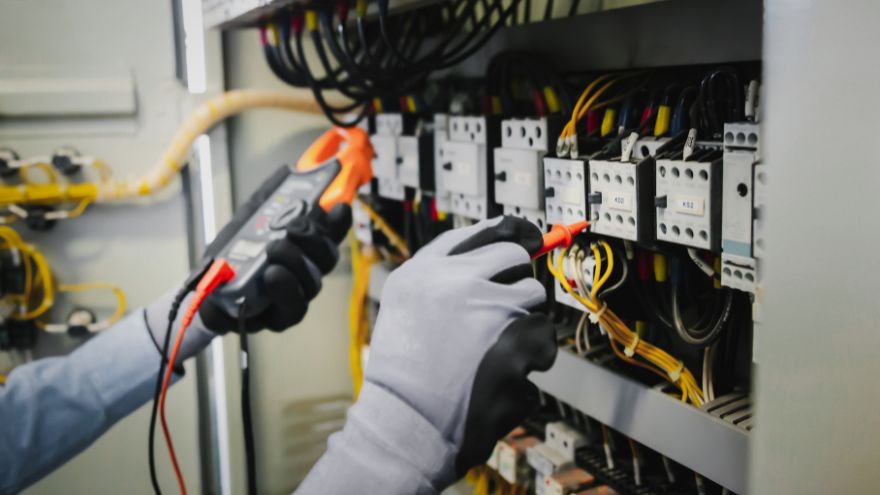Electrical devices require a maximum voltage specified in their parameters to operate correctly. In Poland, it is 230 volts and was set at this level in 2002. It does not always reach its maximum values. Sometimes, unwanted voltage drops occur. What can cause them and what are their effects?

Check the voltage meters at the Onninen wholesaler
What is voltage drop in an electrical installation?
Electric voltage is a parameter that indicates the difference in potential between two points in an electric circuit. It can be most simply defined as the ability of electric energy to perform work. What causes voltage drops in the home electrical network?
 Voltage drops are situations in which a potential difference occurs. It can occur between the ends of insulators, semiconductors or conductors. In practice, it means that devices connected to the source do not receive electricity at a voltage of 230 V, but, for example, 220 V.
Voltage drops are situations in which a potential difference occurs. It can occur between the ends of insulators, semiconductors or conductors. In practice, it means that devices connected to the source do not receive electricity at a voltage of 230 V, but, for example, 220 V.
If we want to observe this phenomenon "with the naked eye", we can, for example, check whether we do not have a problem with dimming light bulbs in our home. If their light is not uniform, it may mean that there are fluctuations in the supply voltage in the lighting network.
We can also check the electric voltage using special devices. For this purpose, a voltage meter will be useful. An alternative would be an electric meter . It allows you to check the values of the current flowing, such as current intensity, voltage, resistance or frequency. Thanks to it, we will find out whether the connectors in the house transmit them appropriately.
Permissible voltage drop
Voltage drops are not uncommon. Small ones occur regularly and do not cause major problems. This applies to situations in which voltage fluctuations are within acceptable standards. These are specified in the PN-HD 60364-5-52:2011 standard. It states that the permitted voltage drop in low-voltage installations is 3% for lighting circuits and 5% for other circuits.
The permissible voltage drop values have been calculated so that despite their occurrence, the correct operation of the electricity receiver is possible. Therefore, you do not have to worry that the electricity meter will show a voltage of 226 V instead of 230 V.
What are the dangers of large voltage drops in the electrical installation?
 Things don't look so rosy when there is a greater voltage drop. First of all, devices connected to electrical installations may stop working. This applies to situations in which the receiver has a low input voltage range. This problem is most common in the case of routers, alarm systems, computers, LED bulbs or gas furnaces.
Things don't look so rosy when there is a greater voltage drop. First of all, devices connected to electrical installations may stop working. This applies to situations in which the receiver has a low input voltage range. This problem is most common in the case of routers, alarm systems, computers, LED bulbs or gas furnaces.
To combat the effects of insufficient voltage, manufacturers increasingly decide to use switching power supplies. Thanks to them, even if the current does not have sufficient voltage, the device is able to work normally.
Problems with operation are not the only risk when the supply voltage is too low. Devices with a low input voltage range are quite sensitive to such situations. In the worst case, they can even be damaged. Cables are also at risk, as they can overheat due to voltage spikes.
What causes voltage drops?
 When looking for the causes of voltage drops, it is worth first ruling out damage to the power supply cable of the connector in which it occurs. Sometimes, even when the electrical circuit has been well designed, voltage drops can occur. The chance of such a phenomenon depends on the length of the cables, the materials they are made of, or the cross-sectional area of the wire in the cables.
When looking for the causes of voltage drops, it is worth first ruling out damage to the power supply cable of the connector in which it occurs. Sometimes, even when the electrical circuit has been well designed, voltage drops can occur. The chance of such a phenomenon depends on the length of the cables, the materials they are made of, or the cross-sectional area of the wire in the cables.
Voltage fluctuations are also caused by rusty contacts. If moisture gets into the connection circuit, corrosion can attack, which disrupts the flow of current through the wires that make up the installation. Voltage drops can also be caused by too much load on the electrical network. If devices that load the circuit heavily operate at the same time in the house, there is a risk of fluctuations. Contact resistance also affects drops. This parameter indicates the load capacity of the entire electrical system.
If you want to measure resistance, it is worth using a proven earth resistance meter . Such devices are available in the Onninen wholesaler. There you will find proven Sonel brand meters, such as the Sonel MRU-200-GPS WMPLMRU200GPS earth resistance meter model. Products from other brands are also offered. For example , the FLUKE 1630-2 FC clamp earth resistance meter and the 4829532 leakage current clamp meter are available. For field use, the compact Sonel MRU-10 WMPLMRU10 earth resistance meter will work well.